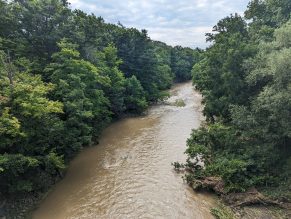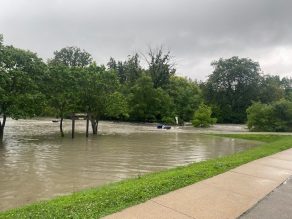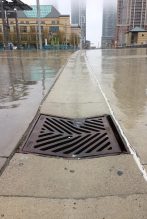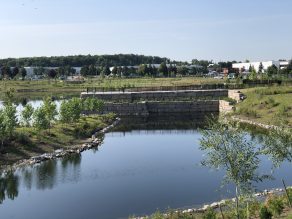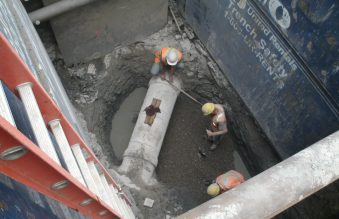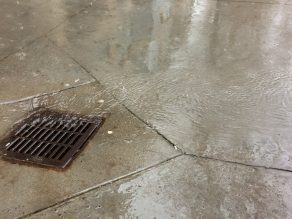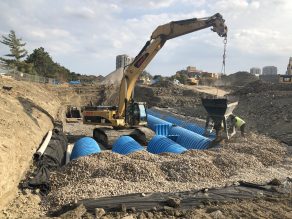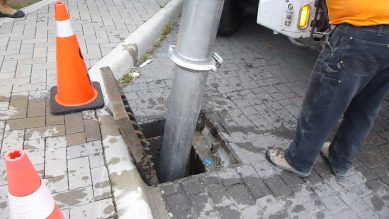Mississauga’s stormwater infrastructure important in historic 100-year storms
The City’s stormwater infrastructure has helped to mitigate the impact of near-record rainfall, demonstrating its role in assisting with protecting the city during extreme weather events.
Environment | August 19, 2024
A critical, but largely invisible, infrastructure system has helped the city from being completely washed away from a few major storms. Stormwater is the rain or melted snow that flows or runs off properties and roads and drains along streets, ditches, storm drains, and watercourses into Lake Ontario. The City’s stormwater infrastructure has helped to mitigate the impact of near-record rainfall, demonstrating its role in assisting with protecting the city during extreme weather events.
Over the course of the summer, heavy rain falling in a short period of time caused high water levels and localized flooding on roads and along creeks, rivers and streams. The July 16 storm saw more than 106 mm of rainfall and the August 17-18 storm brought upwards of 170 mm to some areas in Mississauga.
While some parks flooded, trails washed out, embankments eroded, debris flowed into neighbourhoods, and some residents experienced property damage like basement flooding or water pooling in their backyards – it would have been worse without the City’s stormwater infrastructure actively managing the situation. It handled the majority of the unusual quantity of rain as a result of its network of underground pipes, designated stormwater ponds, culverts and overland flow routes along roadways.
About Mississauga’s stormwater system
Separate from the sanitary wastewater system, the City’s stormwater system collects stormwater from properties and carries it to a receiving waterbody. Maintaining this system lessens the risk of flooding, reduces creek erosion and protects water quality. This is important as it protects you, your property, aquatic habitats, wildlife and Lake Ontario.
Projects funded by the City’s stormwater charge, protected flood-susceptible lands downstream within the Cooksville Creek watershed.
Additional stormwater management facilities in the Cooksville watershed have been constructed underneath existing parks in the last ten years that support reduction of peak flows in large storm events. These include facilities underneath Eastgate Park, Sandalwood Park and Mississauga Valley. These enhancements were key in significantly reducing the impact of flooding.
Lake Saigon – the stormwater management pond at Matheson Blvd. E. and Hurontario St. was designed to hold back flows that result in increased protection of the more flood susceptible lands downstream within the Cooksville Creek watershed. Lake Saigon held back 250,000m3 of stormwater, and therefore reduced the amount of flooding downstream. This one pond held back the equivalent of 100 Olympic-sized swimming pools of water from flowing downstream to homes and businesses.
These infrastructure improvements were key in mitigating the impact of flooding within the city, highlighting the importance of the City’s stormwater charge as a critical investment.
The stormwater system serves to safeguard the city against unpredictable storms of this scale, helping to protect our communities and the lives of residents. Last June, the City approved its first Stormwater Master Plan, Build Beautiful. The approved long-term plan will refine the City’s stormwater program, management systems, and infrastructure. It will help the City address issues facing Mississauga today and, in the future, including flooding, water quality, and pollution while working to preserve our environment.
Climate change and rainfall
With climate change unfolding, we will see storms like this happen more frequently. Every degree of temperature change, even one degree warmer, can impact our environment significantly. This could mean more widespread flooding with rainfall levels expected to increase in volume and intensity, with more frequent and intense precipitation. It’s important that we manage stormwater to reduce flooding risk to your property, lower erosion of our creeks and limit the amount of pollution entering Lake Ontario.
This isn’t the first time Mississauga has experienced heavy rains. On July 8, 2013, more than 10 years ago, the city experienced a storm where more than 126 mm of rain was recorded at Toronto Pearson airport over a stretch of 10 hours. Another recorded storm was in 1954 –Hurricane Hazel, which dropped more than 200 mm of rain over Mississauga in 24 hours.
Stormwater infrastructure is sized to convey flows based on “peak intensity”. For example, 50 mm of rain falling intensely over 2 hours is more likely to cause issues in the urban environment than if 50mm of rain fell slowly over 2 days. In addition to peak intensity, the total amount of rain can overwhelm storm drainage systems. These two factors (i.e. intensity and total rainfall) help to define storms by assigning a specific return period. That is to say, more intense and higher volume storms occur less often whereas less intense, lower volume storms can occur several times every year.
The scale used for these storms return periods ranges from a 2-year storm up to a 100-year storm. A “2-year” storm is a rainfall event of certain duration that has a 50 per cent probability of occurring in a given year, so relatively more often. Whereas, in theory, a “100-year” storm has a 1 per cent probability of occurring in a given year, so relatively less often. It is important to understand that while these return periods help us to understand the nature of a storm, they are theoretical values. In other words, a 100-year storm could occur twice in one year. It is just that it is less likely to happen. Rainstorms during the summer are generally more localized where it may only impact a certain part of the City.
Currently, the City has more than 1,900 kilometres of storm sewer pipes in its drainage system. If laid out end-to-end, these pipes would connect Mississauga to Winnipeg. The stormwater drainage system also includes more than 51,000 catchbasins, 270 kilometres of ditches, 150 kilometres of creeks, and 81 stormwater management facilities (including ponds, underground storage, and Low-Impact Development facilities) that help to collect, drain, and clean the city’s rainwater runoff before it enters Lake Ontario, the source of our drinking water.
Stormwater charge
The Stormwater Charge has made a real difference in the delivery of the City’s stormwater program. It helps with the operations and maintenance of our stormwater systems including necessary activities like cleaning out our catchbasins. These collect rain and snow melt to provide property and road drainage in neighbourhoods, and also trap debris, preventing litter and pollutants from flowing to our creeks.
The stormwater drainage system is one of the largest assets owned and operated by the City of Mississauga. The 2024 Corporate Asset Management Plan estimated a replacement value of $7.6 billion.
In 2024, we have allocated $33.7 million for stormwater improvements, focusing on projects along Cooksville Creek, Etobicoke Creek, and erosion control initiatives. Since 2016, we have invested over $231.5 million in stormwater infrastructure. Our 10-year plan includes an additional $340 million for ongoing upgrades and maintenance to enhance our resilience against future storms. And, we remain committed to continued investments in further enhancing our stormwater infrastructure to withstand future weather events like this one. These investments include stormwater ponds, new pipes in the ground, and repairs to creek and river banks to prevent erosion.
2024 Capital funded projects
Approved 2024 projects funded at $33.7 million, which include:
- Mississauga LRT Storm Sewer Improvements
- Malton Drainage Improvements – Etude Dr. to Justine Dr.
- Design for Dixie Dundas Drainage Improvements by Little Etobicoke Creek
2024 Planned construction projects: Creek, erosion control work and stormwater management facility projects
- Construction of a pumping station at the south-east corner of Doug Leavens Blvd and the Lisgar channel
- Etobicoke Creek erosion control and rehabilitation (Ponytrail Dr. to Bloor St.)
- Sawmill Creek erosion control and rehabilitation (Folkway Drive to Erin Mills Parkway)
- McKenzie Park Storm Water Management Facility
- Sheridan Creek erosion control and rehabilitation (Lushes Avenue to behind Fletchers Valley Crescent)
- Cooksville Creek improvement and flood protection and replacement of King Street Bridge
- Dredging and rehabilitation of Dixie Road Bus Rapid Transit pond
- Dredging and rehabilitation of Tomken Road Bus Rapid Transit pond
10 -Year Capital Plan
2024–2033 projects to be funded at $340 million and include:
- Design and Construction of Pond Dredging and Rehabilitation at Lake Wabukayne & Aquitaine (2025)
- Malton Flood Relief Project (Etude Dr. to Justine Dr.), including construction of a stormwater box culvert beneath the pedestrian walkway, full reconstruction of the walkway to safely create an overland flow route, and an upgraded outfall structure and channel in Derry Greenway Park (2025 – TBD)
- Dundas & Lakeshore BRT Storm Sewer Improvements (2025)
- Design and Construction of Cooksville Flood Storage Facility – Greyshale Park (2027) and Heritage Hills Park (2028–2030)
- Dixie and Dundas Drainage Improvements (2025, 2027–2033)
- Construction of Sawmill Creek Erosion Control–Erin Mills Parkway to The Collegeway (2029)
Read the 2024-2027 Business Plan and the 2024 Budget for Stormwater.
The need for continued infrastructure funding
Over the next 10-years, the City’s Stormwater program will build, expand, and maintain our stormwater system. It will be fully funded by the Stormwater Charge. However, there is still a need to appropriately contribute to the Pipe Reserve Fund to allow for the future replacement of the City’s aging storm water pipes.
The City is seeking a commitment from federal and provincial governments and is advocating for additional funding to help bridge the infrastructure gap. This is crucial for underlining priorities, such as stormwater infrastructure, that are vital to the safety of our community.
Learn more about the City’s stormwater program and dedicated charge here.
Read the 2024-2027 Business Plan and the 2024 Budget for Stormwater.
Watch our stormwater video.
Tags
Media contact
City of Mississauga Media Relations
media@mississauga.ca
905-615-3200, ext. 5232
TTY: 905-896-5151
